<> Tirumala limniace (Cramer,[1775]) <>
the Broad Blue Tiger ผีเสื้อลายเสือฟ้าแถบกว้าง
Click on any photo to see all photos full size in Lightbox
Additions and corrections to the information provided on this page is always welcome. Please use the Contact form.
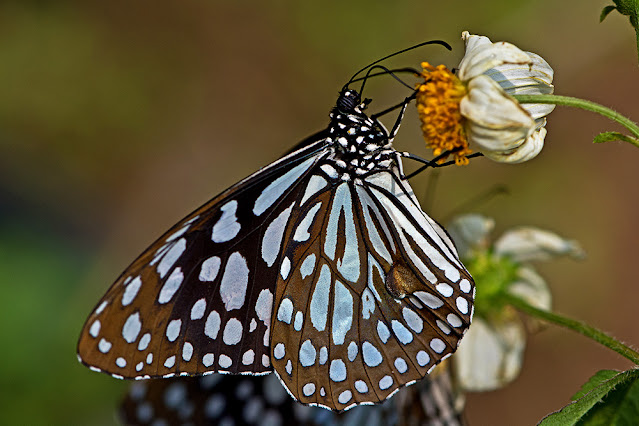
Photo taken at Doi Suthep-Pui National Park, Chiang Mai, Thailand ♂ 400m a.s.l.

Tirumala limniace is a fairly common and widespread species that is found throughout the SE Asia region. There is very little difference in colour and markings between the sexes but the female is slightly larger. The best way to distinguish between the two in the field is by the presence, or not, of the androconia, the male sex organ on the underside of the wings. Both sexes are very enthusiastic nectar feeders which is when they are most often seen, mainly in late morning and late afternoon. They are very rarely seen mud puddling. They have a slow to moderate undulating flight.
The species is multivoltine with several broods per annum. Eggs are laid singly mainly on the under sides of young leaves on the host plant but occasionally on the stems. Up to around 25 eggs can be laid by a single female on the same host plant in a day.
Synonyms and previously used names: Papilio limniace, Danais limniace, Danaida limniace, Danaus limniace
Taxonomy: Animalia - Arthropoda - Insecta - Lepidoptera - Nymphalidae - Danainae - Tirumala - limniace
Regional subspecies: Tirumala limniace conjuncta (Indonesia), T.limniace exoticus (Bangladesh, W.Malaysia), T.limniace leopardus (N.India, S.Myanmar), T.limniace limniace (Myanmar, Thailand, Laos, Cambodia, Vietnam, S.China, Taiwan), T.limniace makassara (Sulawesi-Indonesia), T.limniace orestilla (Philippines), T.limniace tumanana (Philippines)
Regional Distribution: Nepal, Bhutan, India, Bangladesh, Myanmar, Thailand, Laos, Cambodia, Vietnam, China, Taiwan, Malaysia, Indonesia, Philippines
 |
| Doi Suthep-Pui National Park, Chiang Mai, Thailand. 460m a.s.l. |
Habitat: Tirumala limniace is found in a wide range of different habitats including evergreen and deciduous forest, grassland, scrubland, hillsides, agricultural lands, and urban areas. They are usually seen near streams or rivers and have been recorded at elevations up to 2500m a.s.l.
Flight time: all year depending on location Wingspan: 70-80mm
Life History: egg 3-4 days instar 1 2-3 days instar 2 2-3 days instar 3 2-3 days instar 4 2-3 days instar 5 3-4 days pupa 7-8 days Total egg to adult 21-28 days
All times are approximate and can vary depending on the season and on the host used.
Larval Hosts: Asclepias curassavica, Calotropis gigantea, Calotropis procera, Cosmostigma cordatum, Cynanchum annularium, Cynanchum ovalifolium, Heterostemma brownii, Heterostemma cuspidatum, Holarrhena pubescens, Marsdenia lachnostoma, Marsdenia tenacissima, Pentatropis capensis, Stephanotis volubilis, Telosma pallida, Vallaris solanacea, Vincetoxicum dalzellii, Vincetoxicum indicum, Wattakaka volubilis (Apocynaceae), Saccharum officinarum (Poaceae), Crotalaria retusa (Fabaceae)
Actual host plant used depends upon location and availabilty of plant species.
Adult Food Sources: Nectar - Leea indica (Vitaceae), Bauhinia championii, Crotalaria juncea, Crotalaria retusa, Cytisus scoparius (Fabaceae), Duranta erecta, Lantana camara, Stachytarpheta jamaicensis, Verbena rigida (Verbenaceae), Adenostemma lavenia, Ageratina adenophora, Ageratum conyzoides, Bidens pilosa, Chromolaena odorata, Cosmos sulphureus, Crassocephalum crepidioides, Guizotia abyssinica, Gynura nitida, Helichrysum bracteatum, Parthenium hysterophorus, Sphagneticola trilobata, Tagetes erecta, Taraxacum javanicum, Tithonia diversifolia, Tridax procumbens, Vernonia conyzoides, Youngia japonica, Zinnia elegans (Asteraceae), Ehretia laevis, Ehretia pubescens, Heliotropium indicum, Trichodesma indicum, Trichodesma zeylanica (Boraginaceae), Leucas lamiifolia, Plectranthus barbatus, Rotheca serrata, Vitex negundo (Lamiaceae), Cestrum aurantiacum, Solanum mauritianum (Solanaceae), Hypericum japonicum, Hypericum mysorense (Hypericaceae), Justicia japonica (Acanthaceae), Sida acuta (Malvaceae), Oplismenus undulatifolius (Poaceae), Oxalis latifolia (Oxalidaceae), Verbascum thapsus (Scrophulariaceae), Trichilia connaroides (Meliaceae), Nothapodytes nimmoniana (Icacinaceae), Rhodomyrtus tomentosa (Myrtaceae), Oenothera rosea (Onagraceae), Prinsepia utilis, Rubus ellipticus (Rosaceae), Rhamnus wightii (Rhamnaceae), Euphorbia milii, Euphorbia rothiana (Euphorbiaceae), Celosia argentea (Amaranthaceae), Terminalia pallida (Combretaceae). Other - very rarely seen mud puddling although they have been recorded doing so during migration in India.
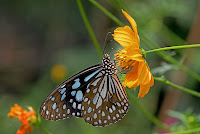 |
| Doi Suthep-Pui National Park, Chiang Mai, Thailand ♂ |
 |
| Doi Suthep-Pui National Park, Chiang Mai, Thailand ♂ |
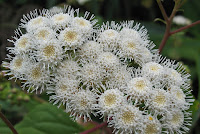 |
| Ageratina adenophora, a nectar source |
 |
| Duranta erecta, another nectar source |
 |
| Kuang Si Waterfall area, Luang Prabang, Laos |
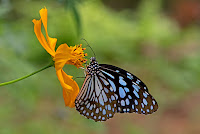 |
| Doi Suthep-Pui National Park, Chiang Mai, Thailand ♀ |
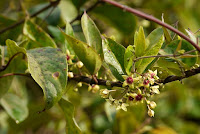 |
| Vincetoxicum indicum, a larval host |
 |
| a late stage larva |
 |
| Doi Suthep-Pui National Park, Chiang Mai, Thailand ♂ |
 |
| Doi Suthep-Pui National Park, Chiang Mai, Thailand ♂ |
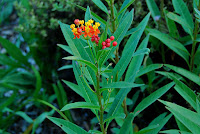 |
| Asclepias curassavica, another larval host |
 |
| pupa |
Links to other pages in this series for species in the same subfamily
